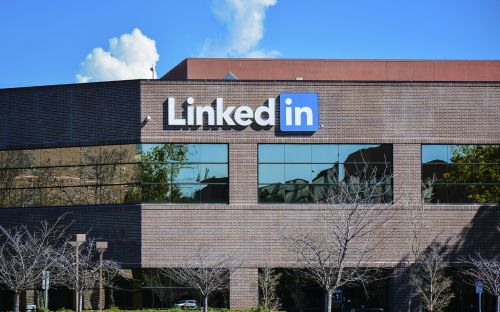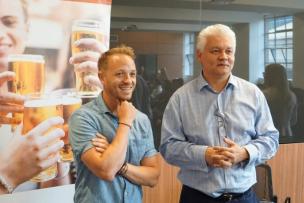LinkedIn is revolutionizing recruitment. The $30 billion professional social network has garnered tens of thousands of companies as clients, including Fortune 500 firms Apple and Chevron, who search for talent among its 400 million users. Using big data and people analytics, the company has become recruiters’ first stop on their hunt for hires.With rapid growth, it is little wonder the world’s top business school students are flocking to the Silicon Valley headquartered company. LinkedIn this year hired from Stanford GSB, Yale SOM, and HEC Paris among others. LinkedIn’s Talent Solutions revenue increased 46% year-over-year to $502 million.
And with talent being the company’s number one operating priority, there is demand for business students to work in various functions, says Chris Brown, director of LinkedIn Talent Solutions UK.
In this exclusive interview with BusinessBecause, the executive explains why big data is the future of recruitment, how online solutions can boost diversity, and LinkedIn’s continuous search for the best and brightest employees.
Since 2012 the NYSE-listed company, which operates from 30 cities globally, has increased headcount from 2,100 to 9,200.
My readers would be keen to know if you value business professionals as hires at LinkedIn.
Yeah [we do]. We have all sorts of functions at LinkedIn. We have over 9,000 employees now so, for business professionals and business students, there are of course opportunities at LinkedIn [UK] and in our offices all around the world.
Is big data the future of recruitment?

It’s happening now. It’s the present. What we’re doing is connecting people with talent with opportunities, but doing that at scale. Being able to match those opportunities or those jobs with people at scale all comes from use of data.
We’re helping companies find better candidates for their roles — people who are actively looking at jobs, but also people who might not be looking for roles — and using that rich profile data to make that matching much quicker and reduce the time it takes to hire.
What are the key benefits of using people analytics to businesses. Is it all about slashing costs, for example by reducing employee turnover?
It’s a mixture. All the companies that use LinkedIn get different value from it.
Very quickly, recruiters can home in on the most relevant people. Being able to do that quickly can remove friction in that recruitment process. Companies find removal of that friction to be a time saver.
We estimate the vast majority of people are “passive” — they might not be looking for jobs but are open to exploring opportunities. That kind of access to passive candidates is the biggest change in the industry in recent years.

What impact is social media having on networking?
For members of LinkedIn, the value proposition is around staying connected. [Social networking] allows us to maintain a network much more easily than we could have done before. The Rolodex is a thing of the past.
It’s easy to keep in touch through a social network and it’s easier to maintain that network.
The other thing members get [from LinkedIn] is being informed about their industry, even if you’re not looking for a job.
What do companies tell you they want to see from LinkedIn users? And what advice do you have for job searchers in the internet age?
The more relevant your profile can be — putting all of your experience online, and using keywords — is key. And building your brand based on what you stand for, and what your purpose is as a professional, but going beyond skills and expertise.
Authenticity is also key. Make sure that what you’re writing online is authentic and human, rather than stale CV descriptions.
Competition in recruitment is said to be tough in some sectors. Does big data offer recruiters a competitive edge?
Absolutely. The data insights allow employers to find the required skills more quickly than ever before, and uncover talent from places that they might not have looked at before — people in different industries for example, or other countries.
Interestingly, there’s not just the searching and the matching: lots of companies we work with in the UK now are realizing the data we can offer helps them position their brand to the right target audience in different ways.
Is there a danger that the use of data could discriminate, creating homogeneous workforces?
When people sign up as a member, we don’t ask for background or gender. So when employers search for matches of candidates, they’re searching based on skills and experience.
We’re supporting all efforts to improve things like diversity and we spend lot of time thinking about it.
How did you get hired by LinkedIn?
I was found on LinkedIn. I wasn’t looking for a role, but I had built a profile. I was using LinkedIn to stay in touch with my customers at the time.
I had invested in my brand, my profile was good enough, and I had invested in my network. My recruitment is a good example of how powerful passive candidate recruiting is with the availability of data. Without LinkedIn, I wouldn’t have had my CV out there.
Will robots and algorithms ever replace recruiters?
No, I don’t think so. I think data brings loads of value, like uncovering talent and helping identify talent pools. But recruiting still needs that human element for companies to understand how they can fulfil their goals and purposes.
Student Reviews
Cultural experience
I have met the most competent and diverse batch in this school. These people not only thrive on their own but also makes sure that you are doing it with them. The professors will take your had and walk you through all milestones and make sure you are not left behind. I have found their extracurriculars extremely engaging. There was always a room to have social life after academic life. The only hindrance is the location of the school, it is slightly outside city and living in city is expensive.
Internationality and diversity of opportunities
About my programme I would say it is very international and flexible: we have the opportunity to choose exactly the courses we want. But at the same time, the frame of the campus is crucial in students' life and enable us to create friendships.
Great selection of people
While HEC's MBA is highly selective, I really enjoy the type of people HEC's selects to make sure everybody gets the best out of their MBA experience and networking opportunities. Not only it's an incredibly diverse pool of people (~60 nationalities) but most importantly they make sure to let in friendly empathic and curious people.
Best in France for Grande ecole
A prestigious business school. Languages are important. It is better to have a scientific baccalaureate with excellent grades in high school and good assessments.
The courses are well designed as per the latest trends and practicality of learning in stressed upon. Overall, a very good experience.
Diversity and quality of fellow students
Very international and interesting place to be and opens a lot of opportunities, however the administration is very french and facilities are subpar (gym, classrooms) meaning the academic affairs is pretty much useless and lastly we are graded on a curve which can create a toxic environment because of the competition. With that being said the pros outweighs the cons by far.
The quality of the teachers, the campus, the clubs
The school is very international indeed, we have courses with international students and share things with them within the extra academic life (in the social clubs especially). We have great career prospects if we prepare ourselves well - however, the global curriculum is still very finance-oriented, which is a pity for other interesting domains of the company world, which does not rely on finance only. The social clubs are good practice for the management and for now, are quite independent.
HEC Paris awaits you
HEC Paris is really a nice place to do a master's in business. Many classes are useful and interesting (corporate finance, financial accounting, contract law…), some are less - but the curriculum is to be reviewed in the year to come. Regarding the student life, it is incredible, with about 130 clubs, lots of great parties with even greater people. The Jouy campus offers a lot of opportunities to do sports, and you can breathe fresh air every day. HEC also helps a great deal to find an internship or a job.
A dream institute
Enrolling in the HEC MBA was by far the best decision I made for myself. The people and faculty are great, with lots of opportunities to meet people and expand your horizons. Very nice campus where I have had some good running sessions.
The alumni network is superb and very helpful. It also has a good support system for entrepreneurs. Would definitely recommend it!
Good choice for a career boost
The classes were extremely practical and relevant to the current challenges that businesses are facing. You have access to a wide range of professionals and good career prospects once you leave the university.
Cultural experience
I have met the most competent and diverse batch in this school. These people not only thrive on their own but also makes sure that you are doing it with them. The professors will take your had and walk you through all milestones and make sure you are not left behind. I have found their extracurriculars extremely engaging. There was always a room to have social life after academic life. The only hindrance is the location of the school, it is slightly outside city and living in city is expensive.
Internationality and diversity of opportunities
About my programme I would say it is very international and flexible: we have the opportunity to choose exactly the courses we want. But at the same time, the frame of the campus is crucial in students' life and enable us to create friendships.
Great selection of people
While HEC's MBA is highly selective, I really enjoy the type of people HEC's selects to make sure everybody gets the best out of their MBA experience and networking opportunities. Not only it's an incredibly diverse pool of people (~60 nationalities) but most importantly they make sure to let in friendly empathic and curious people.
Best in France for Grande ecole
A prestigious business school. Languages are important. It is better to have a scientific baccalaureate with excellent grades in high school and good assessments.
The courses are well designed as per the latest trends and practicality of learning in stressed upon. Overall, a very good experience.
Diversity and quality of fellow students
Very international and interesting place to be and opens a lot of opportunities, however the administration is very french and facilities are subpar (gym, classrooms) meaning the academic affairs is pretty much useless and lastly we are graded on a curve which can create a toxic environment because of the competition. With that being said the pros outweighs the cons by far.
The quality of the teachers, the campus, the clubs
The school is very international indeed, we have courses with international students and share things with them within the extra academic life (in the social clubs especially). We have great career prospects if we prepare ourselves well - however, the global curriculum is still very finance-oriented, which is a pity for other interesting domains of the company world, which does not rely on finance only. The social clubs are good practice for the management and for now, are quite independent.
HEC Paris awaits you
HEC Paris is really a nice place to do a master's in business. Many classes are useful and interesting (corporate finance, financial accounting, contract law…), some are less - but the curriculum is to be reviewed in the year to come. Regarding the student life, it is incredible, with about 130 clubs, lots of great parties with even greater people. The Jouy campus offers a lot of opportunities to do sports, and you can breathe fresh air every day. HEC also helps a great deal to find an internship or a job.
A dream institute
Enrolling in the HEC MBA was by far the best decision I made for myself. The people and faculty are great, with lots of opportunities to meet people and expand your horizons. Very nice campus where I have had some good running sessions.
The alumni network is superb and very helpful. It also has a good support system for entrepreneurs. Would definitely recommend it!
Good choice for a career boost
The classes were extremely practical and relevant to the current challenges that businesses are facing. You have access to a wide range of professionals and good career prospects once you leave the university.
Diverse
HEC, as an academic institution, serves as a launching pad for students to excel in their pursuits and careers. The diversity among students and professors is truly remarkable. The chance to attend seminars across five major continents is unparalleled. The exposure and relationships it fosters are invaluable.
Super diverse
It's a super diverse and fascinating environment with tons of chances, but the management is very French, and the facilities like the gym and classrooms are not great. This makes the academic side quite ineffective. Plus, we're graded on a curve, leading to a competitive and sometimes toxic atmosphere. Despite all that, the benefits definitely overshadow the drawbacks.
Surreal academic experience
What stood out to me about HEC was the direction and insight it offered on coding approaches. Prior to joining the program, I attempted self-learning, but I felt disoriented and lacked a starting point.HEC enabled me to grasp the basics of programming and provided support when I encountered obstacles. Without that guidance, I doubt I would have achieved the progress I have made to date.
Good security
HEC boasts a dedicated team of security personnel who undergo rigorous training to ensure the perpetual maintenance of tranquility and orderliness within the institution. Their unwavering efforts are directed towards fostering a sense of security among the student body, thereby enabling them to channel their energies predominantly towards their academic pursuits.
Innovative teaching method
I am thoroughly enjoying my time at HEC, from the innovative teaching methods to the welcoming campus environment, which is particularly supportive of international students. The extracurricular opportunities, such as sports and associations, are incredibly valuable. Additionally, the career services offered are exceptional. Overall, I find my experience at HEC to be truly enriching.
mim
HEC Paris has been a transformative experience for me. The caliber of the faculty, the diversity of the student body, and the global network it offers are unmatched. The curriculum is highly flexible, allowing students to tailor their learning experience to their career goals, and the focus on real-world application through case studies and consulting projects provides invaluable hands-on experience. The campus itself is beautiful, and the opportunities to engage with leading companies through internships, competitions, and networking events have been incredible. HEC truly prepares you to be a leader in today's complex business world. I couldn’t have asked for a better program to propel my career forward.
Unwavering enthusiasm
Here's the first paragraph:
I embarked on a journey to Paris, where HEC University welcomed me with open arms. As I stepped onto its prestigious campus, I was captivated by the infectious energy and innovative spirit that filled the air. The passionate faculty, industry experts, and fellow visionaries from around the globe shared their knowledge with unwavering enthusiasm."
Exceptional Experience
HEC offers an exceptional experience that I highly recommend. The small-town setting allows for a unique blend of academic rigor and community engagement. The peaceful campus and close-knit student body create a warm environment. Proactive engagement with professors yields valuable guidance. Friendships may blossom slowly, but persistence pays off. The city's beauty, scenic views, and diverse eateries near campus enrich the experience. University dining may not impress, but it's decent.
A Transformative Experience
Attending HEC Paris is an exceptional experience, combining world-class education with personal and professional growth opportunities.
The courses are incredibly engaging, delivered by highly qualified professionals who are specialists in their domains and often work or have work experience in prestigious companies. Far from being purely theoretical, the programs emphasise practical, hands-on learning, allowing students to dive deep into whichever area they want to specialise in. The variety of elective courses is remarkable - you can explore anything from advanced financial techniques to more cultural disciplines like politics, arts, and cinema.
Beyond academics, the student life at HEC is vibrant and dynamic. With over 50 student associations to join, there's something that will fit for everyone. Whether you are passionate about entrepreneurship, sports, arts, cuisine, social causes or anything else, HEC offers a space to explore and develop your interests.
The campus itself is well-equipped, providing students with everything they need for a comfortable and enriching experience. From excellent accommodations and sports facilities with professional coaching to a sprawling green area perfect for walking or relaxing, the environment is both stimulating and tranquil. And with Paris just a short bus ride away, students have the added benefit of easy access to one of the world's most beautiful cities.
However, what truly sets HEC apart is the unparalleled networking opportunities it provides. The school fosters connections through daily conferences in various fields of business (and not only business), networking events, site visits, and alumni cocktails. The alumni network is incredibly powerful, opening doors to countless opportunities and making it easier to connect with professionals in your dream field. The career center is another standout feature, offering invaluable support to help students navigate their career paths.
In conclusion, HEC Paris is much more than a top-tier European business school - it’s a transformative experience that equips you with the knowledge, skills, and connections to achieve your goals while also helping you discover what you’re truly passionate about.
Exceptional and esteemed institution
My time at HEC Paris was nothing short of incredible! The exceptional faculty, cutting-edge curriculum, and breathtaking campus exceeded my expectations. But what truly made my experience stand out was the diverse and dynamic community. I forged lasting bonds with people from all corners of the globe and gained invaluable insights from their unique perspectives.
The career prospects and alumni network that come with graduating from HEC Paris are unparalleled. I feel privileged to have been part of this esteemed institution and wholeheartedly recommend it to anyone seeking a top-tier business education.
My study Experience at HEC Bussiness School
Programs are generally tought in English and have Strong academic foundation and access to practical business knowledge.
Located in the center of Paris with good environment and professors.
But the administration is very slow and annoying.
And secondly if your financial situation is not strong than i don't think it will be a smart choice.
Very satisfied with teaching style
I chose HEC Paris for its strong sense of community. While other colleges offered identical academic degrees, HEC Paris' pleasant culture and helpful environment really spoke to me. The tough courses, competent professors, and extensive career preparation have given me a well-rounded educational experience. I would not exchange my experience at HEC Paris for anything. Given their commitment and energy, I believe they are eager to learn and engage in class. I am confident that my time at HEC Paris will prepare me for a great future, and I am pleased to be a part of it.
Everyone’s excited to be here
HEC Paris has been a fantastic experience for me, going much beyond academics! The professors are great mentors who walk us through cutting-edge principles and practical applications. We're talking about innovative ideas, industrial partnerships, and global opportunities that can help us prepare for a global future.HEC Paris achieved the ideal balance between tradition and innovation. HEC Paris strikes the optimal blend between demanding academics and a supportive community. The instructors are excited about what they teach and are always willing to help, ensuring that you do not just study but also grasp the content.
Wouldn’t change a thing
I had an incredible experience at HEC Paris. The classes are interesting, the lecturers are excellent, and I believe I am gaining a useful education. This institution's people and faculty are outstanding, and while here, I discovered my actual self. I always feel comfortable on campus because it is the safest place in town. The students at HEC Paris are unquestionably its greatest asset.All of the students are determined to succeed and have a strong passion for a variety of activities. The level of diversity you encounter is extraordinary.










